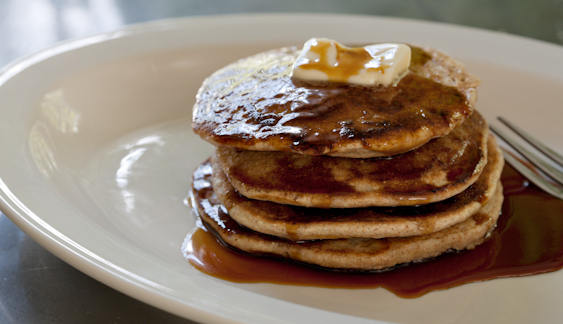Graham Griddlecakes

introduction
Lacy-crisp on the surface, with crackling flecks of shaved bran and a creamy interior, these griddlecakes carry just a trace of burnt toffee in their finish. They go far beyond the world of regular pancakes and demand nothing special from the cook in return.
equipment mise en place
For this recipe, you will need a small saucepan, a small bowl, a well-seasoned 10- to 12-inch cast-iron skillet or similarly sized griddle, a large and medium mixing bowl, a whisk, a 3-ounce ladle, a heatproof basting brush, and a metal spatula.
-
-
3ounces (6 tablespoons) unsalted butter, plus additional for serving
-
1¼cups whole milk, plus additional to thin the batter, if needed
-
5.4ounces (about 1 cup) Anson Mills Rustic Coarse Graham Wheat Flour
-
2.35ounces (½ cup) Anson Mills Colonial Style Fine Cloth-Bolted Pastry Flour
-
2teaspoons baking powder
-
1teaspoon fine sea salt
-
1large egg
-
Dark amber maple syrup or sorghum, warmed, for serving
-
-
-
Melt the butter in a small saucepan over low heat. Remove it from the heat, tilt the pan, and part the surface foam with a spoon. Spoon 2 teaspoons of clear yellow butterfat into a small bowl and set aside. Pour the milk into the saucepan with the remaining butter to warm it slightly. Set a well-seasoned 10- to 12-inch cast-iron skillet or griddle over medium heat to warm for about 10 minutes while you finish making the batter. The skillet is hot enough when droplets of water flicked onto its surface sizzle on contact.
-
Turn the flours, baking powder, and salt into a large mixing bowl and whisk to combine. Whisk the egg in a medium mixing bowl. Gradually add the warm milk mixture to the egg, whisking constantly. (You can use the saucepan to heat the maple syrup or sorghum.) Pour the liquid ingredients into the dry all at once and whisk lightly until just combined. (The batter may seem thin at first—let the flour swell for a few minutes before using the batter.)
-
Dip a heatproof basting brush in the reserved butter and brush it across the surface of the hot skillet. Drop pancakes one at a time into the pan with a 3-ounce ladle—there will be room for 3 pancakes. (If the batter becomes too thick over the course of making the pancakes, you can thin it with a little milk.) After 2 to 3 minutes, when the pancakes are nicely browned on the bottom and have begun to bubble on the top, flip the cakes and brown the other side, 1 to 2 minutes longer. Transfer the pancakes to a plate and give them to someone to eat with some butter and warm maple syrup or sorghum. Regrease the skillet and cook the next batch of pancakes.